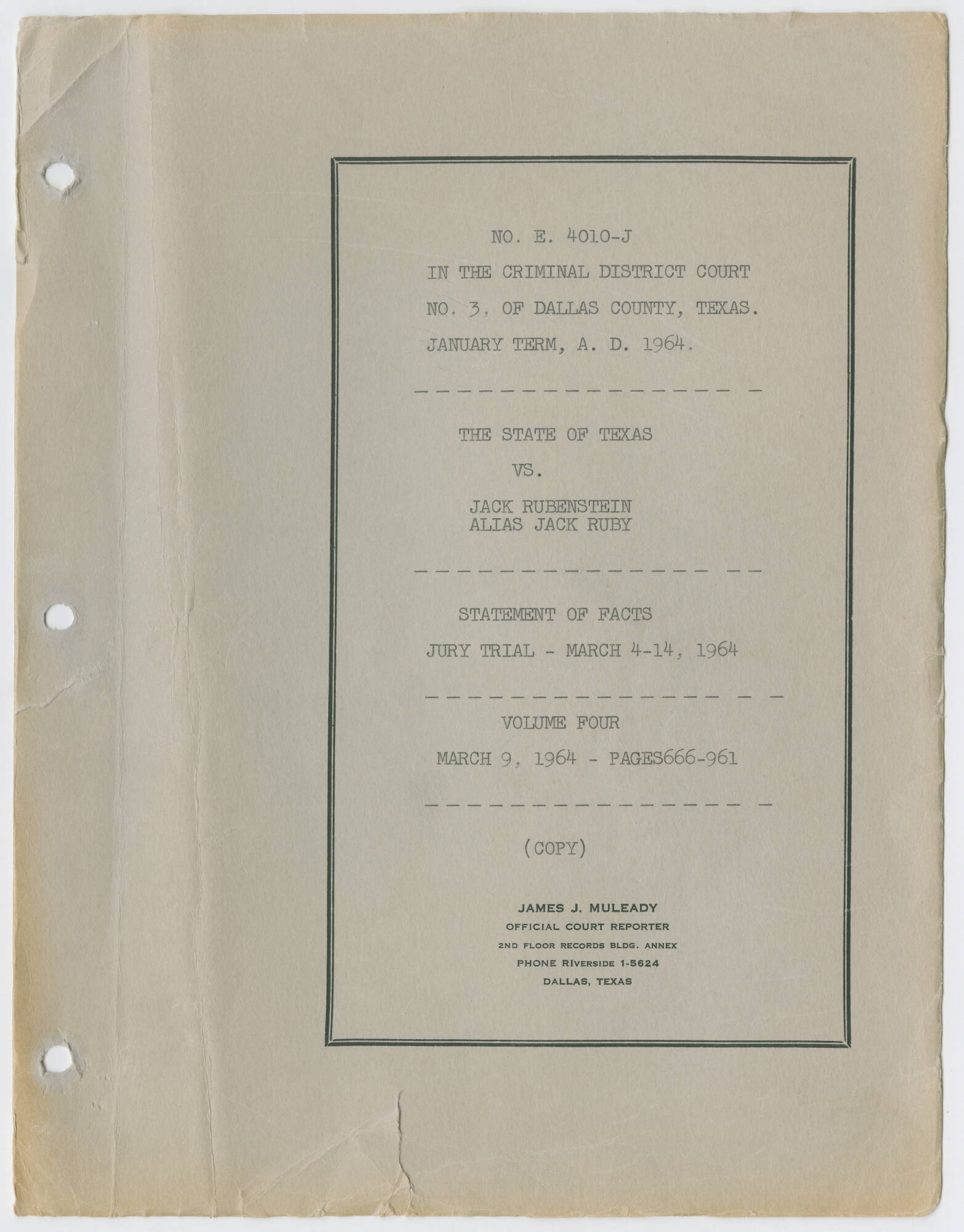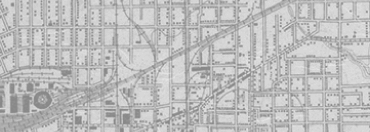


Back
T19 Transcript of the State vs. Ruby: Statement of Facts: Jury Trial, Volume 4
Transcript of the State vs. Jack Ruby: Statement of Facts: Jury Trial, Volume 4.Melvin Belli, Joe Tonahill and Phil Burleson represented the defendant, Jack Ruby; Henry Wade, Dallas County District Attorney, was the prosecutor, assisted by Jim Bowie, Bill Alexander and Frank Watts. The presiding judge was Judge Joe B. Brown.The witnesses who appeared on this day of the trial were Dr. Fred Bieberdorf, Barney Ross, George Senator, Patricia Ann Burge Kohs, Roy Pryor, Icarus N. Pappas, Robert Walker, James R. Davidson, Michael Hardin and Dr. Roy Schafer.The Defense called witnesses. Ross testified to Ruby's childhood nickname "Sparky" being related to his temper. Ruby's Dallas roommate George Senator testified to Ruby's emotional, excitable nature. Dr. Schafer testified he had tested Ruby and diagnosed him with psychomotor epilepsy.Transcript retains original covers and pages are numbered 666 - 961; typed on thin onionskin paper. Each page is individually stamped "Copyright (c) 1964, Shirley M. Stinebaugh - James Muleady, Dallas, Texas". Typed text on the cover:"No. E. 4010-JIn the Criminal District Court No. 3, of Dallas County, Texas. January Term, A. D. 1964.The State of Texasvs.Jack RubensteinAlias Jack RubyStatement of FactsJury Trial - March 4 - 14, 1964Volume FourMarch 9, 1964 - Pages 666 - 961(Copy)"At the bottom is a short printed statement: "James J. MuleadyOfficial Court Reporter2nd Floor Records Bldg. AnnexPhone Riverside 1-5624Dallas, Texas"
T19 Transcript of the State vs. Ruby: Statement of Facts: Jury Trial, Volume 4
03/09/1964
Jack Ruby trial
Trials
Transcripts
Court records
Psychology
Psychiatry
Witnesses
Childhood
Mental health
Epilepsy
EEG
Ruby, Jack
Bieberdorf, Fred
Ross, Barney
Senator, George
Kohs, Patricia Ann Burge
Pryor, Roy
Pappas, Icarus N.
Davidson, James R.
Hardin, Michael
Schafer, Roy
Muleady, James J.
Stinebaugh, Shirley M.
Belli, Melvin
Brown, Judge Joe B.
Tonahill, Joe H.
Burleson, Phil
Wade, Henry M.
Bowie, Jim
Alexander, William F.
Watts, Frank
State of Texas
Criminal District Court No. 3
Dallas County Criminal Courts Building
Dallas County District Attorney's Office
Dallas
Walker, Bob
Paper
11 3/8 × 8 5/8 × 1 1/8 in. (28.9 × 21.9 × 2.9 cm)
Dallas County District Clerk Collection/The Sixth Floor Museum at Dealey Plaza
1994.002.0006.0004
The Museum recorded oral histories with the following individuals named in this document: first aid technician Fred Bieberdorf, journalist Ike Pappas, defense attorneys Joe Tonahill and Phil Burleson and Dallas County D.A. Henry Wade. - Stephen Fagin, Curator
Fred Bieberdorf was a senior medical student at Southwestern Medical School when, as a part-time first aid attendant at the Dallas city jail, he became the first person with any medical background to examine Lee Harvey Oswald after he was shot by Jack Ruby. A few minutes later, when a station wagon ambulance arrived, Bieberdorf climbed in the back with Oswald and detective Jim Leavelle and rode to Parkland Memorial Hospital. However, as he recalled in his 2007 oral history with the Museum, he immediately got a ride back to Dallas police headquarters as soon as Oswald was taken into Parkland's Emergency entrance. Upon his return, Bieberdorf was given the task of conducting an examination of Jack Ruby. Bieberdorf explained, "They thought Ruby might be suicidal, so they had me talk to him for a while.... And they also requested that I do a rectal examination on him to make sure he had not secreted some means of committing suicide, some Strychnine or something in his rectum.... He seemed perfectly calm and relaxed at that time. I didn't ask him why he did this or any such thing as that. And he didn't volunteer anything, other than he didn't like the rectal exam I gave him." - Stephen Fagin, Curator
The late WNEW Radio reporter Ike Pappas was among the closest bystanders to the Oswald shooting in the basement of Dallas police headquarters. In his 1993 oral history with the Museum, he provided one of the most vivid eyewitness accounts of that historic moment: "I say, 'Do you have anything to say in your defense?' And just as I said 'defense,' boom! [Jack Ruby] jumps out, shoots him right in front of me, you know. I heard footsteps and then, boom, and then I saw this flash on his black sweater and Oswald moaned, and he went down. All I saw was a black streak in front of me, too. I didn't know who that was. That was just some guy who jumped right out and shot him. And I felt the impact of the bullet as it creased the air. I felt this explosion of the weapon. I was that close. And I went like that [jumping back], and all these things are going on in my head very, very, very rapidly. And I said to myself, 'Did I get shot? Am I shot?' You know, and I looked down... I had read where sometimes you could get shot and not even know it, you know." - Stephen Fagin, Curator

T19 Transcript of the State vs. Ruby: Statement of Facts: Jury Trial, Volume 4
Transcript of the State vs. Jack Ruby: Statement of Facts: Jury Trial, Volume 4.Melvin Belli, Joe Tonahill and Phil Burleson represented the defendant, Jack Ruby; Henry Wade, Dallas County District Attorney, was the prosecutor, assisted by Jim Bowie, Bill Alexander and Frank Watts. The presiding judge was Judge Joe B. Brown.The witnesses who appeared on this day of the trial were Dr. Fred Bieberdorf, Barney Ross, George Senator, Patricia Ann Burge Kohs, Roy Pryor, Icarus N. Pappas, Robert Walker, James R. Davidson, Michael Hardin and Dr. Roy Schafer.The Defense called witnesses. Ross testified to Ruby's childhood nickname "Sparky" being related to his temper. Ruby's Dallas roommate George Senator testified to Ruby's emotional, excitable nature. Dr. Schafer testified he had tested Ruby and diagnosed him with psychomotor epilepsy.Transcript retains original covers and pages are numbered 666 - 961; typed on thin onionskin paper. Each page is individually stamped "Copyright (c) 1964, Shirley M. Stinebaugh - James Muleady, Dallas, Texas". Typed text on the cover:"No. E. 4010-JIn the Criminal District Court No. 3, of Dallas County, Texas. January Term, A. D. 1964.The State of Texasvs.Jack RubensteinAlias Jack RubyStatement of FactsJury Trial - March 4 - 14, 1964Volume FourMarch 9, 1964 - Pages 666 - 961(Copy)"At the bottom is a short printed statement: "James J. MuleadyOfficial Court Reporter2nd Floor Records Bldg. AnnexPhone Riverside 1-5624Dallas, Texas"
T19 Transcript of the State vs. Ruby: Statement of Facts: Jury Trial, Volume 4
03/09/1964
Jack Ruby trial
Trials
Transcripts
Court records
Psychology
Psychiatry
Witnesses
Childhood
Mental health
Epilepsy
EEG
Ruby, Jack
Bieberdorf, Fred
Ross, Barney
Senator, George
Kohs, Patricia Ann Burge
Pryor, Roy
Pappas, Icarus N.
Davidson, James R.
Hardin, Michael
Schafer, Roy
Muleady, James J.
Stinebaugh, Shirley M.
Belli, Melvin
Brown, Judge Joe B.
Tonahill, Joe H.
Burleson, Phil
Wade, Henry M.
Bowie, Jim
Alexander, William F.
Watts, Frank
State of Texas
Criminal District Court No. 3
Dallas County Criminal Courts Building
Dallas County District Attorney's Office
Dallas
Walker, Bob
Paper
11 3/8 × 8 5/8 × 1 1/8 in. (28.9 × 21.9 × 2.9 cm)
Dallas County District Clerk Collection/The Sixth Floor Museum at Dealey Plaza
1994.002.0006.0004
The Museum recorded oral histories with the following individuals named in this document: first aid technician Fred Bieberdorf, journalist Ike Pappas, defense attorneys Joe Tonahill and Phil Burleson and Dallas County D.A. Henry Wade. - Stephen Fagin, Curator
Fred Bieberdorf was a senior medical student at Southwestern Medical School when, as a part-time first aid attendant at the Dallas city jail, he became the first person with any medical background to examine Lee Harvey Oswald after he was shot by Jack Ruby. A few minutes later, when a station wagon ambulance arrived, Bieberdorf climbed in the back with Oswald and detective Jim Leavelle and rode to Parkland Memorial Hospital. However, as he recalled in his 2007 oral history with the Museum, he immediately got a ride back to Dallas police headquarters as soon as Oswald was taken into Parkland's Emergency entrance. Upon his return, Bieberdorf was given the task of conducting an examination of Jack Ruby. Bieberdorf explained, "They thought Ruby might be suicidal, so they had me talk to him for a while.... And they also requested that I do a rectal examination on him to make sure he had not secreted some means of committing suicide, some Strychnine or something in his rectum.... He seemed perfectly calm and relaxed at that time. I didn't ask him why he did this or any such thing as that. And he didn't volunteer anything, other than he didn't like the rectal exam I gave him." - Stephen Fagin, Curator
The late WNEW Radio reporter Ike Pappas was among the closest bystanders to the Oswald shooting in the basement of Dallas police headquarters. In his 1993 oral history with the Museum, he provided one of the most vivid eyewitness accounts of that historic moment: "I say, 'Do you have anything to say in your defense?' And just as I said 'defense,' boom! [Jack Ruby] jumps out, shoots him right in front of me, you know. I heard footsteps and then, boom, and then I saw this flash on his black sweater and Oswald moaned, and he went down. All I saw was a black streak in front of me, too. I didn't know who that was. That was just some guy who jumped right out and shot him. And I felt the impact of the bullet as it creased the air. I felt this explosion of the weapon. I was that close. And I went like that [jumping back], and all these things are going on in my head very, very, very rapidly. And I said to myself, 'Did I get shot? Am I shot?' You know, and I looked down... I had read where sometimes you could get shot and not even know it, you know." - Stephen Fagin, Curator










